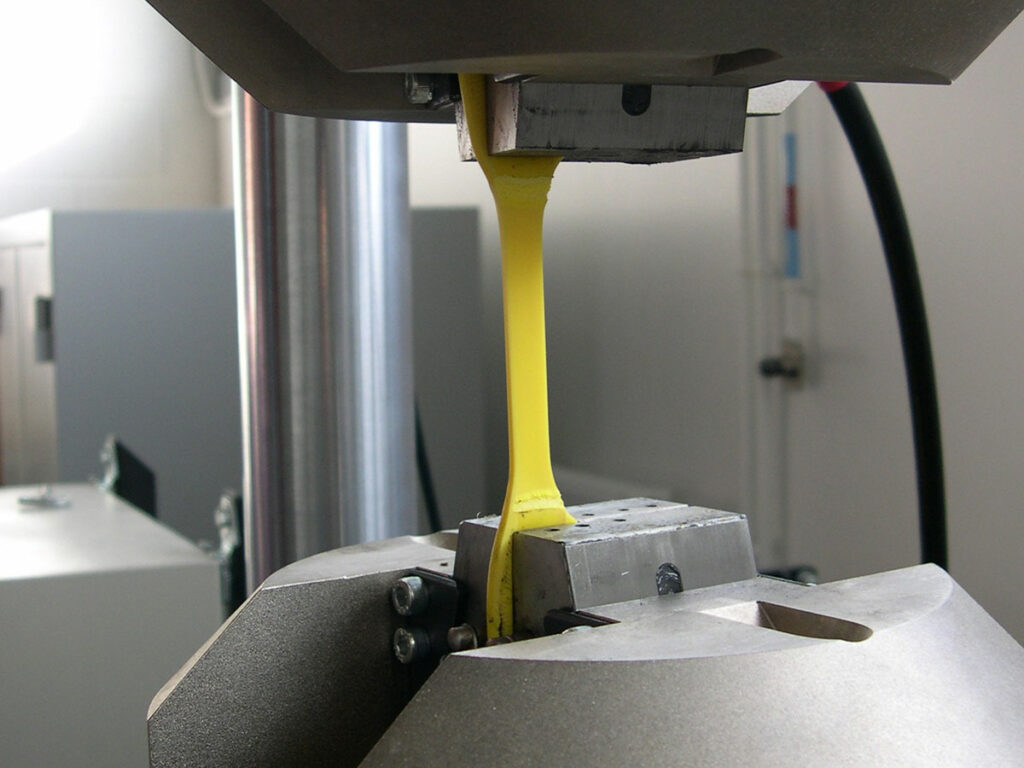Tensile testing is a crucial method for characterizing the mechanical properties of materials in various industrial, research, and manufacturing sectors. By measuring how a material reacts to a progressive tensile force, these tests determine essential characteristics such as yield strength, tensile strength, and elongation at break.
This article will guide you in understanding tensile testing, its importance in material selection and quality verification, and laboratory analysis procedures, taking into account ISO and ASTM standards.
1. What is a tensile test? Definition and basic principles
1.1 Definition of a tensile test
Tensile testing is a standardized mechanical test used to measure the strength and behavior of a material when stretched to breaking point. This test is often performed in a laboratory where a specimen, prepared according to specific standards, is placed in a tensile testing machine. The specimen is subjected to a constant tensile force until it reaches its breaking point, allowing data on its stress and strain to be collected.
1.2 Basic principles of tensile testing
Tensile testing is based on fundamental concepts of physics and mechanics. Stress, or the internal resistance of a material, is measured as the deformation caused by the applied force. When a material is stretched, its molecular bonds gradually expand, reaching a limit beyond which it undergoes plastic deformation and then breaks. The stress-strain curve visualizes the behavior of the material by showing the different phases: elasticity, plasticity, and rupture.
2. Parameters measured in a tensile test
2.1 Tensile strength
Tensile strength represents the maximum stress that the material can withstand before breaking. It is expressed in megapascals (MPa) and calculated by dividing the maximum applied force by the initial cross-sectional area of the sample.
2.2 Elastic limit and Young's modulus
The yield strength is the maximum stress to which a material can be subjected without permanent deformation. Young's modulus, or elastic modulus, expresses the stiffness of the material by measuring the slope of the tensile curve in the elastic phase. This parameter is crucial for understanding whether a material will return to its original shape after the stress is removed.
2.3 Elongation at break and ductility
Elongation at break represents the material's ability to deform before breaking. A high percentage indicates a ductile material, while a low percentage corresponds to brittle, poorly malleable materials.
2.4 Poisson's ratio
Poisson's ratio is a measure of the transverse reduction versus longitudinal elongation of a material under tension. This coefficient is essential for anticipating the behavior of a material subjected to uniaxial stresses.

3. Tensile Test Procedures
3.1 Preparation of the test piece and applicable standards
Tensile tests must be carried out on specimens prepared according to standards (ISO 6892 for metals, ASTM D638 for polymers). These specimens are standardized to ensure reproducible and comparable results, and can be cylindrical or flat depending on the material.
3.2 Carrying out the test: from fixing the sample to rupture
The specimen is placed in a tensile testing machine equipped with jaws that firmly hold its ends. Once the specimen is secured, the machine applies a progressive tensile force until rupture, while measuring the applied force and the elongation of the specimen.
3.3 Stress-strain curve
The data obtained allow a stress-strain curve to be plotted, which shows the different stages of deformation of the material. This curve provides an overview of the mechanical behavior and properties of the material, from the beginning of elastic deformation to rupture.
4. Methods and equipment used for laboratory tensile tests
4.1 Universal traction machines
Tensile tests are typically performed on universal tensile testing machines, designed to apply controlled force to various material samples. These machines can be equipped with force sensors and strain measurement devices for accurate analysis.
4.2 Tensile test variants depending on the types of stress
In addition to standard tests, variations may include high temperature tensile tests, low temperature tests, or rapid tests to observe deformation under various loading conditions.
4.3 Advanced measurement techniques: spectroscopy, deformation measurement, electronic sensors
Some advanced analyses may involve techniques such as spectroscopy or thermal imaging to monitor microscopic changes in the material during testing.
Are you looking for an analysis?

5. Analysis of tensile test results: interpretation and applications
5.1 Data analysis: strength, elasticity, ductility
The data from the test are used to calculate tensile strength, elongation at break and yield strength. These characteristics provide information on the material's ability to withstand a load before yielding, and make it possible to predict its behavior under different operating conditions.
5.2 Importance of the results for quality control and R&D
Industries use tensile test results to validate material quality, ensure compliance with safety standards, and adjust formulations as part of research and development.
6. Tensile tests on various materials
6.1 Tensile tests on metals
Metals often require tensile testing to verify their ability to withstand high loads. The tests identify properties such as ductility, fatigue strength, and fracture toughness.
6.2 Tensile tests on polymers
Tensile testing of polymers helps determine their elasticity and strength under tension, parameters essential for applications in the automotive, packaging, and medical sectors.
6.3 Tensile tests on composite and ceramic materials
Composites, made of reinforced fibers, and ceramics, known for their rigidity, are tested to evaluate their behavior in the presence of mechanical loads in extreme environments.

7. Standards and regulations in tensile testing
7.1 ISO and ASTM standards for tensile testing
ISO standards (such as ISO 6892) and ASTM standards (such as ASTM D638) specify the test methods and quality criteria that must be followed to ensure reliable results.
7.2 Laboratory certifications and accreditations (ISO 17025, COFRAC)
Accredited laboratories (ISO 17025, COFRAC in France) offer additional guarantees on technical competence and the validity of results, necessary for analyses that comply with industrial standards.
8. Practical applications and industrial importance of tensile testing
8.1 Tensile tests in the automotive and aeronautical industries
In the automotive and aerospace industries, materials are subject to strict safety requirements, and tensile testing allows the selection of alloys and materials capable of withstanding extreme mechanical stresses.
8.2 Usefulness for the construction and infrastructure sectors
Building materials such as concrete and steel are tensile tested to ensure they meet the strength standards necessary for structural durability and safety.
8.3 Applications in the polymer and biomaterials sector
Tensile testing is essential in the manufacturing of medical devices and consumer products, ensuring the reliability of polymer materials and their suitability for performance and durability requirements.
Conclusion
Tensile testing is essential for assessing the mechanical properties of materials in a multitude of industrial applications. By measuring tensile strength, elasticity, and ductility, it provides essential data for design, quality control, and material optimization. Compliance with standards and advanced laboratory techniques ensure the validity of tests, allowing industries to select the most suitable materials and meet performance and safety requirements.




